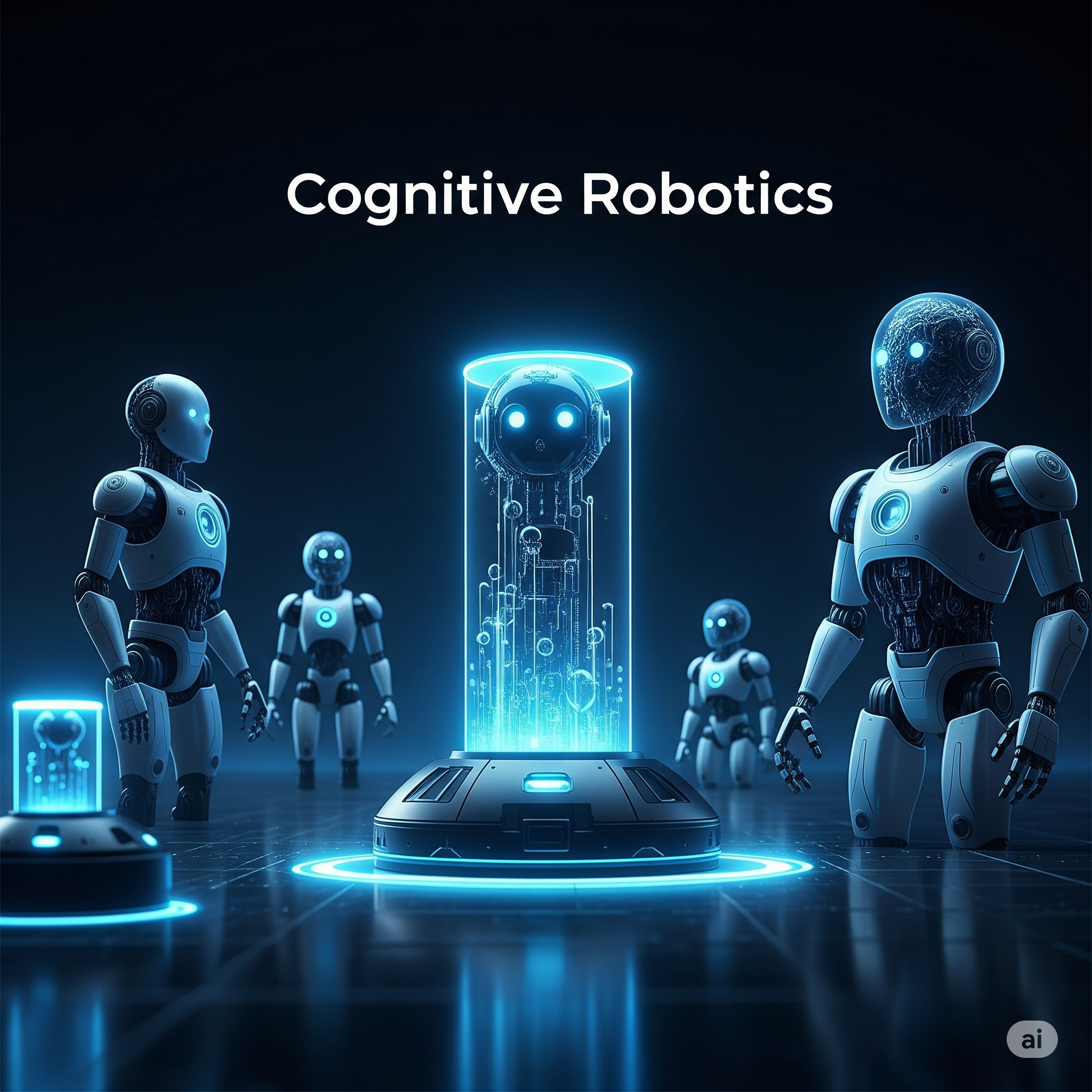Introduction
Cognitive Robotics is an advanced field of robotics that aims to endow robots with intelligent behavior by mimicking human cognitive functions. These include learning, problem-solving, perception, and decision-making. Unlike traditional robots that follow pre-defined instructions, cognitive robots adapt to new situations by learning from their experiences and environments.
In essence, cognitive robotics lies at the intersection of robotics, artificial intelligence (AI), neuroscience, and cognitive science. It forms the basis for the next generation of robots capable of functioning autonomously in dynamic, unpredictable environments—similar to human beings.
Evolution of Robotics Towards Cognition
The journey from industrial robots to cognitive robots reflects a major shift in technological philosophy:
- First Generation (Industrial Robots): Pre-programmed for repetitive tasks in structured environments, with no real-time decision-making.
- Second Generation (Service Robots): Semi-autonomous, capable of limited interaction but still heavily dependent on controlled environments.
- Third Generation (Cognitive Robots): Adaptable, learning-oriented machines with human-like cognitive abilities.
This transition is driven by the demand for robots that can interact meaningfully with people and adapt to real-world complexities, such as autonomous vehicles, healthcare assistance, and human-robot collaboration in workplaces.
Core Components of Cognitive Robotics
Cognitive robotics integrates various scientific and engineering domains. Some of its essential components include:
1. Perception and Sensor Integration
Cognitive robots rely on a variety of sensors (cameras, LiDAR, infrared, tactile sensors) to perceive the world around them. However, unlike simple sensors, cognitive robots understand this data using AI techniques like computer vision and sensor fusion.
2. Learning and Memory
Learning is central to cognitive robotics. Robots use machine learning (ML) and deep learning to learn from experiences. Reinforcement learning helps them improve behavior based on feedback. Additionally, cognitive robots are equipped with memory systems—short-term (working memory) and long-term (episodic memory)—similar to humans.
3. Planning and Decision Making
Using symbolic reasoning, probabilistic models, and decision trees, cognitive robots plan and choose the best course of action under uncertainty. These algorithms allow them to operate effectively in unpredictable environments.
4. Natural Language Processing (NLP)
NLP enables robots to understand and generate human language. With advanced models like GPT and BERT, cognitive robots can engage in meaningful dialogue, comprehend context, and follow complex verbal instructions.
5. Embodied Cognition
This principle argues that cognition is deeply rooted in a robot’s physical experience. In other words, real-world interaction enhances the robot’s cognitive development—mirroring the way infants learn.
Human-Like Abilities in Cognitive Robots
Cognitive robotics strives to replicate a variety of human mental faculties:
- Self-awareness: Some research is directed at giving robots a sense of self-modeling to distinguish their body from the environment.
- Theory of Mind: Future cognitive robots may be able to infer the intentions and beliefs of others.
- Moral Reasoning: Integrating ethics into decision-making is an emerging focus, especially in healthcare and defense.
Applications of Cognitive Robotics
1. Healthcare
Cognitive robots assist in patient care, rehabilitation, and eldercare. They can adapt to patients’ emotions, habits, and needs—unlike static medical devices.
2. Autonomous Vehicles
Cognitive systems in autonomous cars learn from road scenarios, predict driver behavior, and make decisions based on real-time data.
3. Assistive Robotics
Used to support individuals with disabilities, cognitive robots help with mobility, communication, and personal tasks by understanding user preferences and adapting to needs.
4. Manufacturing and Warehousing
In smart factories, cognitive robots collaborate with human workers, respond to anomalies, and optimize workflows without constant human supervision.
5. Search and Rescue Operations
In disaster zones, cognitive robots analyze their surroundings and make decisions autonomously, helping locate and assist victims.
6. Space Exploration
NASA and other space agencies are developing cognitive robots capable of operating in remote extraterrestrial environments where real-time human control is not possible.
Challenges in Cognitive Robotics
Despite its promise, cognitive robotics faces numerous challenges:
1. Computational Complexity
Advanced cognitive processes require immense computational power, which is difficult to achieve with current onboard processors in robots.
2. Learning in Real Time
Real-world environments are unpredictable. Designing robots that learn continuously, safely, and efficiently remains an active area of research.
3. Interpretability and Ethics
Understanding how a robot reached a decision is critical in sensitive fields. Ensuring transparency in AI reasoning is crucial for trust and accountability.
4. Integration of Diverse Technologies
Combining AI, sensor systems, language models, and mechanical components in one seamless architecture is both technically and economically challenging.
5. Human-Robot Interaction (HRI)
Building robots that interact naturally with humans involves not only technical but also psychological and social understanding.
Cognitive Robotics vs. Traditional Robotics
| Feature | Traditional Robotics | Cognitive Robotics |
|---|---|---|
| Learning Ability | Fixed programming | Adaptive, learns from experience |
| Environment Interaction | Structured only | Works in dynamic, unstructured settings |
| Decision Making | Pre-defined logic | Real-time and context-aware |
| Human Interaction | Minimal | Natural language and emotional response |
| Flexibility | Task-specific | Multi-functional and versatile |
Cognitive Architecture Examples
Several cognitive architectures have been developed to implement intelligence in robotic systems:
1. SOAR
A general cognitive architecture used for decision making, problem-solving, and learning in real time.
2. ACT-R (Adaptive Control of Thought – Rational)
A theory that models how humans organize knowledge and produce intelligent behavior.
3. CLARION
Focuses on the interaction between explicit and implicit knowledge, making it ideal for complex decision-making environments.
4. LIDA (Learning Intelligent Distribution Agent)
Designed to simulate a wide range of cognitive phenomena, including perception, attention, learning, and reasoning.
These architectures help researchers design robots with modular and scalable intelligence systems.
Future Prospects of Cognitive Robotics
Cognitive robotics is paving the way for the next AI revolution—robots that think, learn, and interact like humans. In the future, we can expect:
- Emotionally intelligent robots capable of empathizing and responding to human emotions.
- Self-improving machines that can rewrite their own software based on learning.
- Integrated human-robot teams in sectors like defense, disaster relief, and education.
- Ethical frameworks embedded in AI decision-making to ensure responsible robotic behavior.
- Brain-Computer Interfaces (BCI) allowing seamless human-cognitive robot integration.
India and Cognitive Robotics
India is increasingly investing in AI and robotics under initiatives like Make in India and Digital India. Institutions like IITs and IISc are conducting cutting-edge research in cognitive robotics. DRDO and ISRO are exploring cognitive robotics for defense and space missions, respectively. With its large pool of engineers and increasing focus on AI, India could emerge as a leader in this field.
Conclusion
Cognitive Robotics represents a transformative approach to building machines that go beyond automation into the realm of artificial cognition. By blending robotics with AI and human cognitive models, these systems promise to revolutionize industries, healthcare, transportation, and even daily life. Despite current challenges, continued interdisciplinary research is likely to make cognitive robots an integral part of our future society.
As this field evolves, it is crucial to ensure that cognitive robots align with human values, ethics, and safety standards—making them not just intelligent, but also responsible companions in our technological future.




